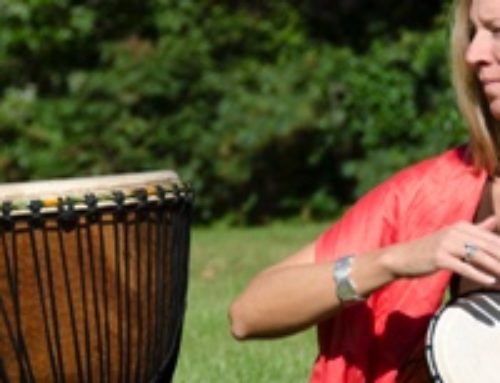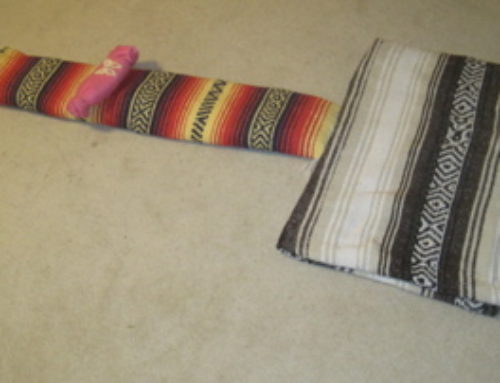Setting the Tone
Yoga Sutra 1.1
With Humility (an open heart and mind), we embrace the sacred study of Yoga. (Nischala Joy Devi in The Secret Power of Yoga)
The First Yoga Sutra: What It Means and How You Can Practice It

Yoga Journal co-founder Judith Hanson Lasater, PhD, and her daughter, Lizzie Lasater, have
partnered with YJ to bring you a six-week interactive online course on Patanjali’s Yoga Sutra.
Through study of this fundamental text, the Lasaters, with more than 50 years of combined
teaching experience, will support you in deepening your practice and broadening your
understanding of yoga. Sign up now for a transformative journey to learn, practice, and live the
sutra.
Patanjali’s first teaching, atha yoga anushasanam, which means “now, the practice of yoga
begins,” is easy to dismiss. But Sutra I.1 isn’t something to skip over on your way to the
good stuff, according to international yoga teacher Lizzie Lasater. Here Lasater explores the
meaning of the first sutra and offers a home practice to honor its wisdom.
begins,” is easy to dismiss. But Sutra I.1 isn’t something to skip over on your way to the
good stuff, according to international yoga teacher Lizzie Lasater. Here Lasater explores the
meaning of the first sutra and offers a home practice to honor its wisdom.
Yoga Journal: What does Sutra I.1 mean to you?
Lizzie Lasater: My mom says that she likes to think of this sutra as “Now the practice of yoga
is shared,” instead of “begins,” and I think that’s a really nice idea about yoga. It is a direct
hand-to-hand lineage, and it is always about sharing.
Lizzie Lasater: My mom says that she likes to think of this sutra as “Now the practice of yoga
is shared,” instead of “begins,” and I think that’s a really nice idea about yoga. It is a direct
hand-to-hand lineage, and it is always about sharing.
But when I first started reading the Sutra, I didn’t take this verse that seriously. Now, the more
time I’ve spent with the text, the more enamored I am. I think it’s a very powerful sutra and it’s
one of my favorites. I like that it’s just three words—it’s extremely simple to hold onto and lends
itself easily to being chanted.
time I’ve spent with the text, the more enamored I am. I think it’s a very powerful sutra and it’s
one of my favorites. I like that it’s just three words—it’s extremely simple to hold onto and lends
itself easily to being chanted.
YJ: What is the significance of the first word, atha?
LL: If we had to reduce the Yoga Sutra down to a single word, that’s the one I would pick.
Atha means now, and that is fundamentally one of the deepest insights of spiritual practice: To
bring us very deeply into the present moment. Atha is this kind of call of action for us to wake
up now. It can be a mantra for daily living that moves off the mat and into our lives, bringing us
back to what’s happening now.
LL: If we had to reduce the Yoga Sutra down to a single word, that’s the one I would pick.
Atha means now, and that is fundamentally one of the deepest insights of spiritual practice: To
bring us very deeply into the present moment. Atha is this kind of call of action for us to wake
up now. It can be a mantra for daily living that moves off the mat and into our lives, bringing us
back to what’s happening now.
You could build a theme for a whole class or a whole practice around atha. Asana itself is
fundamentally a set of building blocks—these positions are designed, in my opinion, to bring
us into the now. They are focusing techniques. When we focus on the breath and on the
sensations of the body, those are all occurring in real time. They are always happening in the
present.
fundamentally a set of building blocks—these positions are designed, in my opinion, to bring
us into the now. They are focusing techniques. When we focus on the breath and on the
sensations of the body, those are all occurring in real time. They are always happening in the
present.
YJ: Can you give us an example of a practice based on this Sutra?
LL: This is a home practice, which ties in perfectly with this sutra. Practice is a space for being
in reality with what’s going on right now—in my body, in my day, in my life. I’ve done this practice
a lot in my own life and I find it to be quite powerful.
LL: This is a home practice, which ties in perfectly with this sutra. Practice is a space for being
in reality with what’s going on right now—in my body, in my day, in my life. I’ve done this practice
a lot in my own life and I find it to be quite powerful.
Here’s what I suggest: Take your phone, put it on airplane mode, and set a timer for 15 minutes.
Roll out your mat, lie down, bend your knees and spread the feet wide to the edges of the mat.
Then let your knees come gently together, close your eyes and bring your hands onto your
belly. Now, think about the idea of atha and ask it to yourself as a question. What do I need
right now? What does my body want right now? Listen in stillness and silence for the answer
to arise.
Roll out your mat, lie down, bend your knees and spread the feet wide to the edges of the mat.
Then let your knees come gently together, close your eyes and bring your hands onto your
belly. Now, think about the idea of atha and ask it to yourself as a question. What do I need
right now? What does my body want right now? Listen in stillness and silence for the answer
to arise.
The “worst” thing that could happen is nothing—you lie there for 15 minutes or you straighten
your legs and do Savasana (Corpse Pose). That’s the risk, and for most of us that’s actually
really wonderful considering how jam-packed our days are. But every time I’ve done this,
something arises and I start moving and breathing intuitively. This is a much more receptive
kind of practice than imposing our idea of practice on the body.
your legs and do Savasana (Corpse Pose). That’s the risk, and for most of us that’s actually
really wonderful considering how jam-packed our days are. But every time I’ve done this,
something arises and I start moving and breathing intuitively. This is a much more receptive
kind of practice than imposing our idea of practice on the body.
This interview has been lightly edited for length and clarity.
About Our Experts
Judith Hanson Lasater, PhD, PT, has been teaching yoga since 1971. She trains students
and teachers throughout the United States as well as abroad, is one of the founders of Yoga
Journal magazine, and is president of the California Yoga Teachers Association. She
has written eight books. Learn more at judithhansonlasater.com.
Judith Hanson Lasater, PhD, PT, has been teaching yoga since 1971. She trains students
and teachers throughout the United States as well as abroad, is one of the founders of Yoga
Journal magazine, and is president of the California Yoga Teachers Association. She
has written eight books. Learn more at judithhansonlasater.com.
Raised in San Francisco and trained as a designer, Lizzie Lasater, MArch, RYT, teaches
yoga internationally and online. She sometimes jokes that she’s been practicing yoga since the
womb because her mom, Judith Hanson Lasater, has been teaching since before Lizzie’s birth.
Lizzie lives in the Alps with her Austrian husband. You can find her schedule and classes at
lizzielasater.com.
yoga internationally and online. She sometimes jokes that she’s been practicing yoga since the
womb because her mom, Judith Hanson Lasater, has been teaching since before Lizzie’s birth.
Lizzie lives in the Alps with her Austrian husband. You can find her schedule and classes at
lizzielasater.com.
The Breath
Breath Awareness – bringing more awareness inside
- Bring awareness to the air moving into the nostrils and out of the nostrils. Observe the feeling, the temperature and any other qualities of the air. Observe the air for at least 4 breaths and you can really notice the qualities of the air coming in.
- Next, follow the air coming in the nostrils to the trachea (wind tunnel) and then follow the air out of the body back through the nostrils. Observe any qualities of the air like temperature, sound, pressure, etc.
- Finally folllow the air from the entry of the nostrils down to the lungs and then back out of the lungs through the nostrils. What sensations do you have physically? What is happening with your thoughts and are you feeling anything emotionally?
The Poses
Side Lean
Benefits: Stretches the torso and provides a gentle twist which allows a release in tension in the lower back area.
Lie on right side of bolster with hip at the base of it. Torso should rest on the stack. Right arm should be under the head. The left arm can reach over the head to increase the stretch. Close your eyes and allow your body to relax and release any stress or tension. Slowly sit up and switch sides for the same amount of time.
Focus on your breath. Breath into your right side allowing that gentle stretch to travel from the tip of your fingers down your lower spine. Sense the left side of your body gently melting and surrendering to the ground beneath you. All tension and stress being recycled by mother earth. Sense the gentle letting go of your muscles and knowing that you are safe and supported. Breath deep and exhale soft and long.
Supported Forward Fold
| Chair Version |
Place a block at lowest height and rest the bolster on it horizontally. Sit on a blanket in front of the props and swing your legs over top of the bolster. Adjust the height of the set-up to fit your legs. If your feet do not reach the floor, add a blanket or block. Before folding over the bolster, extend the spine on an inhale and then fold over. Rest hands either on the bolster or on the floor. Add support under arms and wherever else needed. Forehead rests on bolster maybe adding a neck roll. Stay for 5-10 minutes.
Belly Down with Bolster
Props: 2 or more blankets, neck rolls, bolster for feet
Benefits: soothing to the nervous system, grounding, stimulates the
digestive system, gentle chest opener, lengthens the legs, ankles, releases the pelvis
Place a blanket for the chest to lie on as well as fill in the belly area and one blanket for a pillow. Lie belly down with legs extended, arms bent slightly out to the side. Can hold onto your neck roll to ground through the palms. Turn your head to one side and change direction when you need to. Additional support at the ankles. Add a blanket over top for comfort and warmth.





Leave A Comment